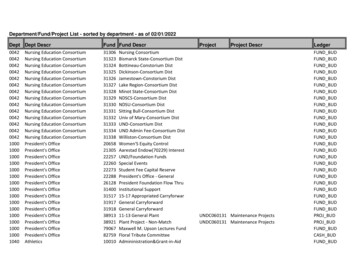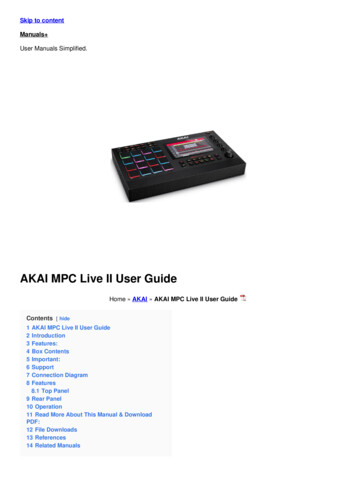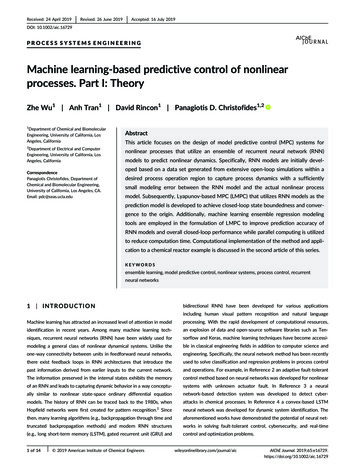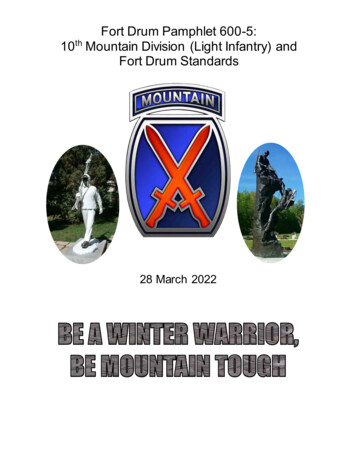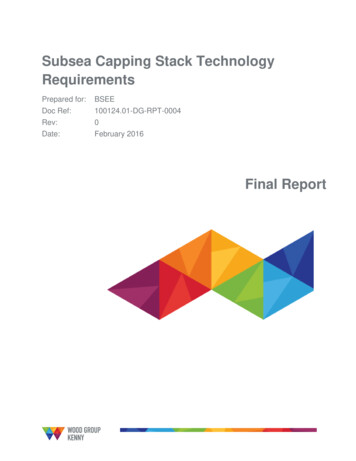
Transcription
The Mountain-Plains Consortium (MPC) is a competitively selected University TransportationCenter, funded by the US Department of Transportation to serve Region 8 – the Upper Great Plainsand the Intermountain West. MPC focuses on Transportation Infrastructure and Operations toSupport Sustainable Energy Development and the Safe Movement of People and Goods." MPC,through the efforts of its faculty and staff, strives to be a leader in transportation by promoting itscritical importance to the nation’s infrastructure, energy development, and safety through research,interdisciplinary education, workforce development, and technology transfer while serving theunique and critical needs of the Mountain-Plains Region.Participating Universities include: Colorado State University North Dakota State University South Dakota State University University of Colorado Denver University of Denver University of Utah University of Wyoming Utah State UniversityIMPACT BY THE NUMBERS30 Undergraduate courses83 Graduate courses12 Master’s level programs11 Doctoral level programs21 Undergraduate students participating in transportation research169 Graduate students participating in transportation research51 Master’s students earned degrees9 Doctoral students earned degrees50 Research Projects275 Peer-reviewed journal articles and conference papers presented by faculty orstudents185 Graduate and undergraduate students participating in MPC research projects260 MPC supported events (conferences, workshops, seminars, symposia,distance learning classes, etc.)6,038 Number of transportation professionals participating in those events 11,646,918 Matching dollars leveraged for research over the life of the current MPC grant
Alejandro Henao: 2015 Student of the YearHenao is a transportation engineering PhD student incivil engineering at the University of Colorado-Denver.Henao is president of the Institute of TransportationEngineers Student Chapter and student leader of theactive communities/transportation research group.For his dissertation, he is evaluating the accuracyof new information technologies and analyzing thetravel behavior impacts of such technologies andevolving transportation services. Alejandro holds anMS in civil engineering from CU Denver and a BS incivil engineering from CU Boulder. He received theEisenhower Fellowship, an NSF Bridge to DoctorateProgram Fellowship, and an NSF IGERT Fellowship.Henao worked extensively on the Mountain-PlainsConsortium project, "Building a Framework forTransportation Resiliency and Evaluating the ResiliencyBenefits of Light Rail Transit," and has published severalpapers in peer reviewed journals and presented this workat numerous national conferences. His other research topics include: transportation infrastructureinvestments, mode share changes, and parking around sporting event stadiums. Henao plans tocontinue to conduct research focused on creating more sustainable and equitable places withrespect to active transportation, multimodal and intermodal options, information technologies, andevolving transportation modes.The USDOT’s University Transportation Centers program recognizes students of the year foreach region at the Annual Council of University Transportation Centers Winter Banquet held inconjunction with the Transportation Research Board Annual Meeting each January in Washington,DC. The 1,000 award is based on accomplishments in research, academic performance,professionalism and leadership.32015 MPC Annual Highlights
IMPACT THROUGH EDUCATIONMPC faculty members taught 30 undergraduate courses and 83 graduate courses last year atparticipating universities. Students (21 undergraduate and 169 graduate) were also involved inMPC research projects. MPC funds also support 12 master’s level degree programs and 11 doctoralprograms. MPC’s educational plan is consistent with national goals to: Introduce transportation concepts in elementary and secondary educationProvide vocational and technical trainingBuild transportation degree programs that are international and multidisciplinaryProvide mid-career transportation trainingTo accomplish these goals, MPC universities incorporate new technology and transportationconcepts into programs and coursework to provide tomorrow’s transportation professionals keyconceptual and practical knowledge. Programs and courses are increasingly offered online, to makethem more accessible to those already employed or are looking for mid-career training. Studentsinvolved in MPC research provide valuable insight and expertise while gaining experience andexposure to real-world transportation issues.For more information on educational programs offered by MPC cooperators, visit http://www.mountain-plains.org/education/Students visit Utah Traffic LabThe University of Utah ITE chapter invites groups to visit campus facilities and tour the Traffic Laband driving simulator. In April 2015, more than 300 potential undergraduate engineering studentstoured the engineering building and asked questions about transportation engineering and theTraffic Lab. A group of students from Kearns (UT) junior and senior high schools visited the TrafficLab and learned about transportation engineering and how the work of traffic engineers impact thequality of life of the people and safety on roadways.2015 MPC Annual Highlights4
NDSU celebrates National Transportation WeekFor National Transportation Week in 2015, staff at North Dakota State University’s Upper GreatPlains Transportation Institute mailed activities such as coloring pages, word finds and crosswordpuzzles to elementary schools across North Dakota to teach students about the importance oftransportation. Industry experts gave invited lectures on campus to boost transportation awarenessamong the campus community. Staff members cooperated with Fargo’s transit provider, MATBUS,in visiting an area middle school to teach students about the benefits of public transportation andpotential careers in transportation.Scholarships awardedWith funding from the MPC, the Upper Great Plains Transportation Institute at NDSU recognizedfour future leaders in transportation. The Paul E.R. Abrahamson Scholarship recognizes outstandingstudents at NDSU with an interest in the transportation and logistics of agricultural products.Winners of the 1,500 scholarships in 2015 were Jacob Chisholm, a senior in agricultural economicsfrom Gary, MN, and Molly Collette, a senior in agribusiness from Grafton, ND. The TransportationEngineering Scholarship recognizes academic achievement and promotes the education oftransportation students at NDSU. Winners of the 1,500 scholarships in 2015 were Matthew Lee,a senior in civil engineering from Dilworth, MN, and Dylan Dunn, a senior in civil engineering fromFargo, ND.Chisholm5ColletteLeeDunn2015 MPC Annual Highlights
STUDENT IMPACTCSU student honored for paper and posterCSU Colorado State University PhD student Yufen Zhou was selected runner-up in the best studentpaper competition for a paper about cable loss on long-span bridges during the ASCE EngineeringMechanics Institute (EMI) annual conference at Stanford University in June. She also received thebest student poster award from the poster competition held by EMI Experimental Analysis andInstrumentation Committee.Student is Eisenhower fellowUniversity of Colorado Denver PhD student Kara Luckey was selected as a DwightD. Eisenhower Fellow. Her dissertation focuses on the relationship between urbaninfrastructure and community development. She is also engaged in researchrelated to neighborhood change processes, residential location decision-making,transportation and housing equity, and public transit’s role as a community andeconomic development tool.LuckeyUniversity of Utah student named Pikarsky Award winnerJeff Taylor received the Milton Pikarsky Memorial Award. The award is chosen annually by theCouncil of University Transportation Centers (CUTC) for the best PhD dissertation and MS thesisin the field of science and technology in transportation studies. Two awards are given for PhDdissertations and MS theses each year (for a total of four awards). MS thesis award recipientsreceive a 1,500 honorarium accompanied by a plaque. The awards were presented at the CUTCAnnual Awards Banquet in January 2015. The title of Jeff’s thesis is "Computational Methods forInvestigating Intradriver Heterogeneity Using Vehicle Trajectory Data."Student named to Duluth Port PostKate Ferguson, a student in NDSU’s Masters of Managerial LogisticsProgram (https://www.ndsu.edu/transportation/mml/), was recentlynamed Director of Business Development for the Duluth SeawayPort Authority. She is the first point of contact for companiespursuing domestic and international trade opportunities and alsocoordinates business expansion prospects with industrial developmentorganizations in the region. Prior to her most recent position as supplychain informatics senior specialist for Essentia Health, Fergusonspent nine years working in transportation logistics based in Duluth.For more info, see http://www.duluthport.com/media-news-detail.php?id 81.2015 MPC Annual HighlightsFerguson6
University of Utah students receive Future Industry Spotlight AwardsThe Future Industry Leader Spotlight Award, given by the American Road and TransportationBuilders Association, recognizes students enrolled in undergraduate or graduate studies at aU.S. college or university who have achieved an outstanding academic record and demonstratedextraordinary leadership skills within and outside of the academic environment. The 2015 winners areboth PhD students in civil and environmental engineering from the University of Utah.Anusha Musunuru is focused on developing aframework for more reliably informing causationand/or occurrence-mechanism of trafficcrashes. She hopes that her research will leadto more appropriate transportation investmentsand act as a catalyst to create a safe andsustainable multimodal transportation systemthat contributes to a community’s economichealth and quality of life.7Ivana Tasic conducts research with a focus onurban multimodal transportation. Her researchincludes quantifying the traffic impacts of trafficoriented development, crash modificationfactors for intersections and a light rail transitanalysis in Salt Lake City.2015 MPC Annual Highlights
FACULTY IMPACTPaper on Engaging First-Year Engineering Students honoredAtaderoA paper titled “Creating Inclusive Environments in First-YearEngineering Classes to Support Student Retention and s/56/papers/12401/view) by Christina Paguyo, a postdoctoral fellow in the Collegeof Engineering at Colorado State University, and CSU MPCProgram Director Rebecca Atadero won two best paper awardsat the American Society for Engineering Education AnnualConference in Seattle, in June. Additional authors were WestVirginia University faculty member Karen Rambo-Hernandezand WVU graduate student Jennifer Francis. The paper wonBest Diversity Paper and Best Paper for the First Year ProgramDivision. The paper addresses the question: How do freshmenengineering students in traditional engineering courses identifywith engineering and perceive diversity in engineering?Ozbek is research coordinator for TRB committeeMehmet E. Ozbek, associate professor of constructionmanagement at Colorado State University, was appointedresearch coordinator for the Transportation Research Board'sStanding Committee on Maintenance and OperationsManagement which is concerned with all aspects of managingthe maintenance and operations of highway transportationfacilities.Kim is outstanding reviewer, twiceOzbekAn associate professor in the Department of Civil Engineeringat the University of Colorado Denver was honored by twopeer-reviewed journals in 2015 as an outstanding reviewer.Jimmy Kim was recognized by the American Society of CivilEngineering’s Journal of Bridge Engineering and by the Journalof Construction and Building Materials. Kim’s expertise isin structural engineering with an emphasis on sustainablestructural rehabilitation using advanced composite materials,bridge engineering, emerging materials and computationalmodeling.Kim2015 MPC Annual Highlights8
Wehbe elected Fellow of ASCENadim Wehbe, professor of civil and environmental engineeringat South Dakota State University was elected fellow of theAmerican Society of Civil Engineers (ASCE). He was recognizedwith other newly elected ASCE fellows at the ASCE NationalConvention in New York City in November. Fellow statusis conferred upon members who have made celebratedcontributions to the society and developed creative solutionsthat change lives around the world. The prestigious honor isheld by less than 3.5 percent of members. Wehbe is also a fellowof the American Concrete Institute (ACI) and the StructuralEngineering Institute (SEI).Wehbevan de Lindt9NIST awards 20M to CSU to study resiliencyThe National Institute of Science and Technology recentlyawarded Colorado State University 20 million to establishthe Community Resilience Center of Excellence over 5 yearsfocusing on resiliency to communities affected by disasters. TheCenter will be led by CSU professors of civil and environmentalengineering John van de Lindt and Bruce Ellingwood. van deLindt is an MPC researcher. They will be working with NISTresearchers and partners from nine other universities to developcomputer tools to help local governments decide how each canbest invest resources intended to lessen the impact of extremeweather and other hazards on buildings and infrastructuresystems, including transportation infrastructure. The Center alsowill address how to maintain social services and institutions— health care delivery, education, social services, financialinstitutions — as well as economic functions. The Center willinvestigate multi-mode transportation infrastructure, such asbridge and roadway networks, heavy and light rail, airports andport and maritime systems. MPC researcher Suren Chen fromCSU and colleagues from other universities will be conductingresilience research on transportation infrastructure.2015 MPC Annual Highlights
Project: Evaluating Transportation ResiliencyPI: Wesley E. Marshallwesley.marshall@ucdenver.eduMPC researchers at the University of Coloradolaunched a three-part research programexamining transportation resiliency and theability for a transportation system to maintainor return to a previous level of service aftera disruptive event such a drastic gas priceshock. The first part uses a multinomiallogistic regression mode choice model toderive resiliency scenarios of various drivingcost increases. Modal shifts are based on thesupposition that travel behavior will adaptwith increased fuel costs to be more like households with a similar percentage of householdincome being dedicated to transportation. We assess the influence that transit infrastructure, activetransportation, the built environment, land uses, and socio-economic status. The second part focusesin on city-scale resiliency by accounting for active transportation infrastructure in a detailed mannernot feasible at the regional scale. The research applies a “level of traffic stress” methodology thataccounts for both the presence and quality of bicycling, walking, and transit modal options as wellas the presence of barrier roads and highways. We measure the resiliency value of these multimodal transportation infrastructures – even if few people are using those facilities today. The thirdpart develops a Transportation Economic Resilience (TER) rating system. Lead investigator WesleyMarshall says the results illustrate that transportation choice helps create network redundancy andfacilitates adaptability under extreme conditions; alternatively, more suburban locations with fewertransportation options are far more vulnerable. While alternative fuels and improvements to the fueleconomy of vehicles would help reduce the long-term impacts, the most vulnerable householdsare already spending more than 30% of their income solely on transportation costs and would bethe least likely to benefit from technological improvements. Should an extreme event occur, themost resilient households will live in cities and regions that plan for and invest in diversifying andexpanding transportation choice. For more information, search for report MPC-15-279 at www.mountain-plains.org.2015 MPC Annual Highlights10
Project: Indian Reservation Safety ImprovementProgram: A Methodology and Case StudyPI: Khaled Ksaibati, khaled@uwyo.eduImproving roadway safety on Indian reservationsrequires a comprehensive approach, note MPCresearchers at the University of Wyoming.Limited resources, lack of crash data, and a lackof cross-jurisdictions coordination has madeit difficult for Native American communities toaddress their roadway safety concerns. Theresearchers developed methodology to improveroadway safety and successfully implementedit on the Wind River Indian Reservation (WRIR).Lead investigator Khaled Ksaibati and PhDstudent Debbie Shinstine say the key to the success of such a process is collaboration among safetystakeholders. With assistance from the researchers, the WRIR has successfully developed a strategicplan utilizing the available crash data, identified ways to improve reporting, and incorporated theirsafety improvement program into the strategic plan. The report from the project presents programsthat are specific to local reservations’ needs and culture. For more information, search for reportMPC-15-291 at www.mountain-plains.orgProject: A Sensor Fusion Approach to AssessPavement Condition and MaintenanceEffectivenessPI: Raj Bridgelall, raj.bridgelall@ndsu.eduMPC researchers at North Dakota StateUniversity developed an approach to enablesmart pavements. The embedded sensorsreport parameters to determine trafficloading characteristics, structural health, andthe ride quality pavements provide to thetraveling public. This technology will enableagencies to remotely monitor pavement assetscomprehensively, without regularly deployingexpensive field equipment and personnel.In addition to making the sensors more rugged so that they would last throughout the asset lifecycle, Raj Bridgelall, a researcher at NDSU’s Upper Great Plains Transportation Institute, developeda new method that extended the capability of the sensors beyond an ability to measure justpavement loading and condition parameters. Specifically, the research linked the sensor output tocommon roughness indices. To maintain a high accuracy of measuring numerous pavement loadingand condition parameters throughout the life cycle of the pavement asset, an external method ofroughness measurement provided continuous calibration for the sensors. The connected vehiclemethod is a novel technique that utilizes regular vehicles with wireless connectivity to measurelocalized roughness.112015 MPC Annual Highlights
Field experiments validated the theory of using connected vehicles to measure pavement roughness,and in turn the ability to use those results as a means of calibrating the embedded sensors sothat they will maintain long-term accuracy of measuring and reporting a variety of parameters.Through continuous calibration, the embedded sensors will measure and report parameters thatallow agencies to characterize traffic conditions and to assess many aspects of pavement structuralhealth. Numerical simulations further revealed that a sensor placement interval of approximately onemeter will provide agencies with roughness measurement levels that are most significant in makingmaintenance decisions. Therefore, agencies can monitor roughness even when connected vehiclesare not providing similar information.Embedded sensors that remain operational throughout the life cycle of pavement assets will provideagencies with a remote means of monitoring the usage characteristics, health conditions, andservice level of pavements, without deploying expensive instrumented vehicles that can potentiallydisrupt traffic. When smart cities design and construct new pavements with the sensors alreadyembedded in the materials, those pavements will save agencies tens of billions of dollars byeliminating the need to regularly deploy expensive probing equipment and personnel.For more information, search for report MPC-16-306 at www.mountain-plains.orgProject: Utah State Research Will Help SmallCommunities Plan for BicyclesPI: Anthony Chen, anthony.chen@usu.eduBicycle mode share has been increasing inrecent years because of municipal efforts topromote alternative transportation. However,bicycles are often neglected in the travelforecasting modeling process. MPC research atUtah State University addresses this problemby developing bicycle network analysis tools forestimating bicycle trips in smaller communitieswith limited resources.Researcher Anthony Chen developed bicyclenetwork analysis tools that can perform the following functions: initial bicycle origin-destinationdemand generation, bicycle traffic assignment, and bicycle origin-destination demand adjustment.The analysis tools were used to estimate bicycle demand. First, bicycle data was used to develop aninitial bicycle demand matrix. The matrix was then allocated to the bicycle network by bicycle trafficassignment. Finally, the initial bicycle origin-destination matrix was adjusted so that estimated databetter matches the observed data. After the development of the network analysis tools, a case studyat the Utah State University campus was conducted to demonstrate the applicability of the tools.The case study revealed that the majority of estimated link flows matched observed link flows.Consequently, the bicycle network analysis tools developed may prove useful for planningapplications in communities with limited resources. There were, however, some estimated link flowsthat were significantly different from its corresponding observed link flows. These deviations arelikely due to a data inconsistency problem identified in the original travel survey. With more carefuldata collection, the tools developed in this research can be used to analyze bicycle demand andbicycle volumes on a transportation network.2015 MPC Annual Highlights12
The bicycle network tools developed in this study can help governing bodies determine efficientallocation of resources to achieve the regional planning goals. While the study will be relevant tothe Utah Department of Transportation (UDOT) and various Metropolitan Planning Organizations(MPOs), smaller communities may benefit most from the work because they typically do not havethe resources to develop and maintain a full-scale bicycle planning model.For more information, search for report MPC-15-285 at www.mountain-plains.orgProject: Guidelines for Effective LTAP Course EvaluationPI: Jim Dorward, jim.dorward@usu.eduMPC researchers at Utah State University looked at evaluations of the Utah Local TechnicalAssistance Program to assess how the program could strengthen course evaluation tools andprocesses to better facilitate effective instruction to meet course objectives for participants.The National LTAP program funded by the Federal Highway Administration and state departmentsof transportation provides training for both new and long-term local government employees to helpthem keep up to date with technologies and regulations encountered in their jobs. It is vital for thistraining to (1) be accessible to a wide variety of learners and (2) have an immediate impact on theparticipant’s ability to fulfill the essential functions of their job. To achieve the goal, it is necessary toprovide training opportunities that directly facilitate that end. Researchers Ann Heaslip and JamesDorward developed recommendations for developing and using strong course evaluations that couldguide revisions to training programs and help participants feel like they are provided with informationthat can help them better complete their job functions.For more information, search for report MPC-16-305 at www.mountain-plains.org.Project: Alkali-Silica Reaction When UsingRecycled Concrete Aggregate in New ConcretePI: Jennifer Eisenhauer Tanner,tannerj@uwyo.eduAlkali-silica reaction (ASR) is a global concretedurability problem that continues to plaguecertain aggregate sources. A long-term fieldsite was setup at the University of Wyoming toevaluate ASR and mitigation strategies for localaggregates.As shown in the photo, Wyoming wildlife madea home on one of the long term field-exposureblocks. While he rests, the research teamcontinues to provide solutions to make highperformance concrete for the state and beyond.For more information, search for report MPC-15302 at www.mountain-plains.org.132015 MPC Annual Highlights
Project: Development of an Alternative to theDouble Tee Bridge SystemPI: Nadim Wehbe, nadim.wehbe@sdstate.eduMany bridges on the South Dakota localhighway system need replacement due todeterioration or increased traffic demands.Local governments rely on the South DakotaDepartment of Transportation (SDDOT) tohelp replace them but, with limited resources,SDDOT can only help replace about 30 bridgesstatewide each year, causing a backlog of localbridges in need of replacement.Some commonly built bridges on the SouthDakota local highway system need replacementfar before their expected design lives. MPC researchers are looking for alternative bridge designsand developing repair techniques that may extend the lives of those bridges well beyond theirexpected life spans.Most replacement bridges on the South Dakota local highway system are double tee precast girderbridges because they have a relatively low construction cost, an outsourced design, and a shortconstruction duration. The bridges are expected to last 50 to 70 years, but some built less than40 years ago already need replacement. Longitudinal joints in the bridges become damaged overtime, most likely due to inadequate shear transfer between the girders, allowing water and debris toenter the joints. The joints begin to spall, creating a path for moisture to reach the prestressing steel,initiate corrosion, and degrade the structural capacity of the bridge.Routine maintenance of these bridges does increase the life span, but is not a feasible long-termsolution. The amount of routine maintenance required to keep the joints sealed is too costly for localgovernments. Other methods, such as asphalt overlays, are also expensive and can cause increaseddamage over time by trapping moisture that eventually reaches the prestressing steel.South Dakota State University researchers led by Nadim Wehbe are investigating the performance ofthe currently used longitudinal joint detail and to assess the adequacy of a proposed new joint detailfor use with double tee girders and are looking at alternatives to the double-tee precast bridge. Intheir research, they conducted fatigue and strength testing of two full-scale girders, one representingthe as-built conditions and the other representing a modified joint detailing. Results revealed thatthe current joint detailing is severely inadequate if the bridge is to last for 50 years or more, while themodified joint detail provided adequate performance under fatigue loading equivalent to more than70 years of service.2015 MPC Annual Highlights14
Project: Re-Use of Mine Waste MaterialsAmended with Fly Ash in TransportationEarthwork ProjectsPI: Christopher products from mining and burningcoal may be valuable as a base material forbuilding or repairing roads MPC research atColorado State University indicates. Leadinvestigator Christopher Bareither is evaluatingthe mechanical, hydraulic and environmentalbehavior of mixtures of mine tailings, minewaste rock, and fly ash to assess potentialapplications in transportation earthworkmaterial. They hope to develop recommendations for using the materials that will enhance thedurability of transportation infrastructure, reduce disposal concerns, and reduce the amount of soiland gravel that must be mined and moved for road construction. The researchers are using tailingsfrom a Colorado garnet mine and fly ash collected from coal-fired power plants in Colorado andNorth Dakota. Additionally, a synthetic mine tailings blend was created from commercially producedmaterials (silica sand, silica flour, and Kaolinite) to compare mixture behavior to specimens withactual mine tailings and also to results on fly ash-amended soils in literature. Samples are beingsubjected to various mechanical tests to determine strength and durability. Preliminary resultssupport the test methods and show good comparison to previous research.152015 MPC Annual Highlights
OUTREACH/WORKFORCE DEVELOPMENTTechnical TrainingMPC’s technical training program is having a major impact in the region. Online modules, shortcourses, webinars, and on-site/videoconferencing events are reaching state and local transportationdepartment employees and tribal transportation planners. By harnessing the capabilities of the fourLTAP centers located at the MPC universities and the multimedia capabilities of the TransportationLearning Network (which was founded and is partly funded by MPC) more than 76 technical trainingevents were offered in the second half of 2015. These training modules and short courses are criticalto transportation agencies that need to improve or renew the skills of engineering technicians andother frontline workers. Many MPC courses or training events result in the certification of workers.Even when certification is not required, TLN’s online learning management systems allow employeesand employers to set learning goals and monitor progress towards these goals.Graduate StudentsAltogether, 185 undergraduate and graduate students are working on MPC research projectsunder the tutelage of faculty researchers. These graduate students
NDSU celebrates National Transportation Week For National Transportation Week in 2015, staff at North Dakota State University's Upper Great Plains Transportation Institute mailed activities such as coloring pages, word finds and crossword puzzles to elementary schools across North Dakota to teach students about the importance of transportation.


